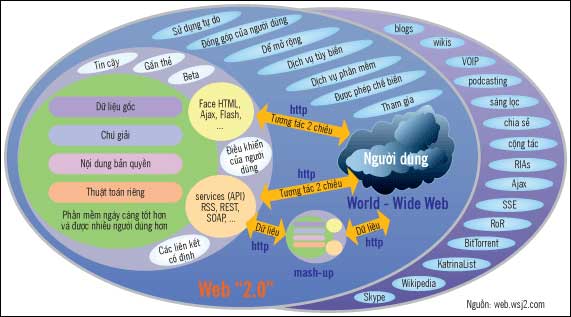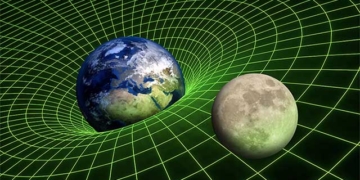Considered a revolution in the online world, the new generation of the web brings significant changes not only in technology but also in usage – creating a community environment where everyone can contribute to the “virtual” society rather than just “browsing and viewing”.
What is Web 2.0? How can we differentiate between Web 1.0 and Web 2.0? The term “Web 2.0” is becoming popular and somewhat overhyped. In essence, Web 2.0 means using the web in line with its true nature and capabilities!
The primary goal of the pioneers who built the Internet was to connect researchers and their computers so that they could share information effectively. When Tim Berners-Lee introduced the World Wide Web in 1990, he aimed to create a medium that allowed users to freely upload information to the Internet and easily share it with everyone (the first web browser created by Berners-Lee included a web page editor). However, the web later developed in a direction somewhat different from its original goals.
Despite some exceptions, the world of Web 1.0 (the generation before Web 2.0) mainly consisted of “closed” websites from news agencies or companies aimed at more effectively reaching readers or customers. It served as a broadcasting tool rather than a medium for sharing information. Only recently, with the emergence of new technologies like blogs (or weblogs), wikis, has the web become more community-oriented (and collaborative), aligning closer with its true expectations and capabilities.
Concept
The concept of Web 2.0 was first introduced by Dale Dougherty, Vice President of O’Reilly Media, at the first Web 2.0 conference organized by O’Reilly Media and MediaLive International in October 2004. Dougherty did not provide a definition but instead used examples to compare and distinguish between Web 1.0 and Web 2.0: “DoubleClick is Web 1.0; Google AdSense is Web 2.0. Ofoto is Web 1.0; Flickr is Web 2.0. Britannica online is Web 1.0; Wikipedia is Web 2.0. etc…”. Later, Tim O’Reilly, Chairman and CEO of O’Reilly Media, summarized seven characteristics of Web 2.0:
- The web acts as a platform that can run any application
- Collective intelligence
- Data is key
- Software is provided as a web service and is continuously updated
- Application development is easy and quick
- Software can run on multiple devices
- Rich application interfaces
Initially, Web 2.0 focused on technology, emphasizing the role of the application platform. However, by the second Web 2.0 conference held in October 2005, the emphasis shifted to a deeper aspect – the community factor.
Technology
In reality, web applications are a very important component of Web 2.0. A range of new technologies has been developed to make web applications “stronger”, faster, and easier to use, which are considered the foundation of Web 2.0.
The technological architecture of Web 2.0 is still evolving but fundamentally includes: server software, content delivery mechanisms, communication protocols, browsers, and applications.
Content Delivery
The first and most important development step towards Web 2.0 is the content delivery mechanism, using standardized protocols to allow users to use information in their own way (meaning the ability to customize information). Many protocols have been developed for content delivery such as RSS, RDF, and Atom, all based on XML. Additionally, there are special protocols like FOAF and XFN designed to extend website functionality or allow user interaction.
Web Services
Two-way communication protocols are one of the key components of the Web 2.0 architecture. There are two main types of protocols: REST and SOAP. REST (Representation State Transfer) is a type of web service request where the client sends the state of all transactions; while SOAP (Simple Object Access Protocol) relies on the server to maintain state information. In both cases, web services are accessed via APIs. The common language for web services is XML, although there can be exceptions.
A typical example of a new generation communication protocol is the Object Properties Broadcasting Protocol developed by Chris Dockree. This protocol allows virtual objects (existing on the web) to know “what they are and what they can do”, thereby enabling them to communicate with each other when necessary.
Server Software
Web 2.0 is built on the architecture of the previous web generation but places greater emphasis on the software that works “behind the scenes”. The content delivery mechanism is only nominally different from the dynamic content delivery method (of Web 1.0); however, web services require more stringent processes and data.
Current solutions developed towards Web 2.0 can be divided into two types: either building most features on a single server platform or developing “add-on” applications for the web server, utilizing API communication.

Community
Technology is just the “surface” of Web 2.0; it is the community of users that is the foundational element creating the new generation of the web. The shift from “browsing and viewing” to “participating” is a true revolution, of course enabled by technological advancements, but here we want to emphasize user behavior towards the web.
The common state of 1.0 generation websites is that they contain many annoyances and operate slowly, seemingly always wanting to convey the message: this is our website, not yours. The root of the problem may stem from website owners feeling they “give away” something. Sometimes website owners believe that making things difficult for users will benefit them! A typical example is some sites that give readers the beginning of an article and then require them to register (whether for a fee or not) to read the rest.
CHALLENGES OF WEB 2.0 • Overhyped: Many people believe that Web 2.0 will put an end to desktop applications and solve all problems in the software field. Web 2.0 applications require a stable and fast Internet connection to work. Unless broadband connectivity is widespread, Web 2.0 is just an addition to how we work (in conjunction with desktop applications). |
Of course, with the popularity of server software, including free software like Apache, users can upload any information to the web. However, many factors hinder this: website creation skills, limitations of Internet service providers, security and censorship issues…
Essentially, Web 2.0 empowers users more and creates an environment that tightly connects individuals. There are now many examples showing that user communities can contribute valuable information when they have the right tools. Wikipedia is perhaps the most famous example. Although many scholars do not highly regard Wikipedia, they forget an important fact: it is good enough, free, and widely accessible. Other examples include sites like Reddit and Digg that allow users to decide what information is important, or del.icio.us which lets people share great web addresses.
Web 2.0 enables anyone to upload any information to the network. With a large number of participants, to a certain extent, through the filtering process, information can become immensely valuable. Here, there is a similarity to the theory of natural selection.
Conclusion
In reality, Web 2.0 is not something entirely new but rather an evolution from the current web. It is still the web as we have known it for a long time; it’s just that now we work with the web differently. Websites are no longer “islands” but have become sources of information and functionality, forming a computing environment that serves web applications and users.
Not a distant vision, Web 2.0 already exists around us with a multitude of new generation websites. The trend towards transitioning to Web 2.0 is occurring robustly and is an inevitable trend.
Phương Uyên
References:
• What is Web 2.0, O’Reilly
• Web 2.0, Wikipedia
• Web 2.0 Blog, web2.wsj.com



















































